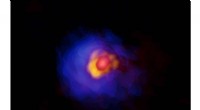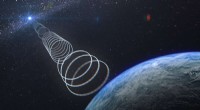
Wetenschap
Why do stars seem to change color?
1. Temperatuur:
* The hottest stars: These stars emit a lot of blue and ultraviolet light, making them appear bluish-white.
* Cooler stars: These stars emit more red and orange light, appearing reddish-orange.
* Our atmosphere: Earth's atmosphere scatters blue light more than red light. This is why the sky looks blue during the day, and the sun appears redder at sunset and sunrise. The same scattering effect can make stars appear slightly redder than they actually are, especially near the horizon.
2. Our perception:
* Our eyes: Our eyes are most sensitive to green light, but we can perceive a range of colors. As a result, the color of a star can appear different depending on its brightness and our individual perception.
* Fotografie: Different cameras and filters can capture different colors of light, leading to variations in how stars appear in images.
3. Apparent movement:
* Atmosferische vervorming: As stars move across the sky, they can appear to twinkle and change color slightly due to turbulence in the Earth's atmosphere.
* Our perspective: De hoek waarop we een ster bekijken, kan beïnvloeden hoeveel licht uit verschillende delen van het spectrum onze ogen bereikt, waardoor de waargenomen kleur wordt beïnvloed.
4. Evolution of stars:
* Rode reuzen: Stars nearing the end of their life cycle expand and cool, becoming red giants. While this is a genuine color change in the star itself, it happens over a long period, making it imperceptible in a human lifespan.
Samenvattend: Hoewel sterren zelf op korte termijn niet van kleur veranderen, kunnen verschillende factoren zoals temperatuur, onze atmosfeer en onze perceptie ervoor zorgen dat ze van kleur lijken te veranderen.
 Is het smelten van ijs een chemische of fysieke verandering waarom?
Is het smelten van ijs een chemische of fysieke verandering waarom?  Welke verklaring beschrijft een chemische eigenschap?
Welke verklaring beschrijft een chemische eigenschap?  Hoeveel liter olie staat er in een 3,1 liter?
Hoeveel liter olie staat er in een 3,1 liter?  Lijst met basisapparatuur voor lassen
Lijst met basisapparatuur voor lassen  Wat hebben wetenschappers nodig om het bewijsmateriaal te bevestigen dat zirkoonkristal is gevonden?
Wat hebben wetenschappers nodig om het bewijsmateriaal te bevestigen dat zirkoonkristal is gevonden?
 Waarom bestaan er zoveel klimaten in Noord- en Zuid -Amerika?
Waarom bestaan er zoveel klimaten in Noord- en Zuid -Amerika?  Er moeten dringend maatregelen worden genomen om de methaanemissies te verminderen, nieuw rapport zegt
Er moeten dringend maatregelen worden genomen om de methaanemissies te verminderen, nieuw rapport zegt Vervuilingsniveaus in Britse steden dalen naarmate het coronavirus het dagelijks leven beïnvloedt, nieuwe gegevens onthullen
Vervuilingsniveaus in Britse steden dalen naarmate het coronavirus het dagelijks leven beïnvloedt, nieuwe gegevens onthullen Het kwikgehalte in vissen fluctueert samen met het waterpeil in meren
Het kwikgehalte in vissen fluctueert samen met het waterpeil in meren Geologen meten de binnentemperatuur van de aarde met behulp van uitgebarsten zeeglas
Geologen meten de binnentemperatuur van de aarde met behulp van uitgebarsten zeeglas
Hoofdlijnen
- Wat is Feedback-inhibitie en waarom is het belangrijk bij het reguleren van de enzymactiviteit?
- Aleppo-momenten:wat zorgt ervoor dat onze hersenen onder druk bevriezen?
- Biologen pakken wereldwijde uitstervingscrisis aan
- Welke cellen bevatten kernen die DNA scheiden van de rest van de cel?
- Hoe vergelijken organen bij dieren en planten?
- Wat is de functie van een transportsysteem in het levende organisme?
- Wat is een verandering in genetische samenstelling van cellen?
- Wordt het bouwen van boerderijen om voedsel te verbouwen dat een menselijk proces wordt genoemd?
- Angiogenese versus vasculogenese
- Leven op aarde:waarom hebben we de manen nu misschien een magnetisch veld ter beschikking gesteld om ervoor te bedanken

- Hoe de kanteling van de aarde zorgt voor korte, koude januaridagen

- Massieve sterren groeien op dezelfde manier als lichte sterren, gewoon groter

- Vreemde radiogolven komen uit de richting van het galactische centrum

- Waar oude satellieten gaan sterven

 Bestaat er een verband tussen muziek en geluk?
Bestaat er een verband tussen muziek en geluk?  wat is meer 10 pond of 161 ounces?
wat is meer 10 pond of 161 ounces?  Criminelen die gespecialiseerd zijn in illegale tabaksverkoop mijden het dark web
Criminelen die gespecialiseerd zijn in illegale tabaksverkoop mijden het dark web Wat is de Meridian Crossing -doorvoertijd voor een wassende halve maan?
Wat is de Meridian Crossing -doorvoertijd voor een wassende halve maan?  Waarom de Middellandse Zee een hotspot voor klimaatverandering is
Waarom de Middellandse Zee een hotspot voor klimaatverandering is Maanvormende schijf ontdekt rond verre planeet
Maanvormende schijf ontdekt rond verre planeet Benzine en het voedsel dat we eten hebben zowel potentieel of welke energie?
Benzine en het voedsel dat we eten hebben zowel potentieel of welke energie?  Klimaatverandering:wat als ziekten zich naar het zuiden verplaatsen in plaats van naar het noorden?
Klimaatverandering:wat als ziekten zich naar het zuiden verplaatsen in plaats van naar het noorden?
- Elektronica
- Biologie
- Zonsverduistering
- Wiskunde
- French | Italian | Spanish | Portuguese | Swedish | German | Dutch | Danish | Norway |

-
Wetenschap © https://nl.scienceaq.com

